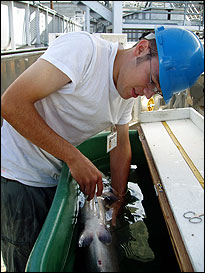RFID use in Columbia fish tracking is about to reach new depths. Digital Angel Corp. is developing an antenna that will read radio frequency identification tags in Pacific Northwest juvenile salmon as they pass through large chutes on their way to the Pacific Ocean, moving as fast as 60 miles per hour.
In the 1980s, with the population of salmon dwindling in the Columbia Basin, the National Marine Fisheries Services and the Bonneville Power Authority (BPA) took an interest in fish tracking via RFID. That kind of tracking was already underway with livestock, and some officials realized the same might work for salmon and steelhead, another endangered river fish.

With eight dams built on the Columbia River, running through Idaho, Washington and Oregon, environmentalists and recreational fisherman wanted the declining salmon population addressed. Since federally owned BPA manages one of the largest of these dams, they were the first to fund salmon-tracking research.
The result was a fish-tracking program using RFID tags that has been carried out with millions of fish over the past 15 years, answering numerous questions about where and why salmon mortality occurs.
For young salmon, RFID tracking begins in one of the many salmon farming areas up river, or in spawning grounds. There, farmers or federal or state employees gather fish in tanks, sedate them and inject full duplex tags known as Passive Integrated Transponder (PIT) tags into their abdomens. The rice grain-sized tag consists of a tiny coil antenna and integrated circuit in a glass encasement. Farmers or researchers then scan the tag and input biological detail about the fish, such as size and weight. That information is directed to the PIT Tag Information System (PTAGIS) database and Web site, where the movement of each fish can be tracked.
After three days in the recovery tanks, the young salmon are released to begin their journey to the ocean. The readers installed at dams send a signal to energize the tags and collect data about the fish as they pass.The dams were constructed between 1938 and 1975, including ladders to help spawning salmon continue their journey up and down the river. By tagging the fish and installing interrogators at the dams, scientists have learned how long it takes for salmon to get from one dam to the next, and at what point many of them are not making the crossing at all. More recently, researchers have been using the tags to determine when fish are captured by birds, what happens to them out at sea and how shoreline development affects them.
Just as important, scientists have been able to learn how they can improve the thoroughfare for salmon at the dams, says Chris Peery, assistant research professor at the University of Idaho, Moscow. And as improvements are made to the dams, the RFID system has had to keep up with those adjustments.
Now, BPA and the U.S. Army Corps of Engineers are testing a giant tube that shoots salmon downstream in great numbers, reducing the bottlenecking that can lead to salmon mortality. Tracking fish through this chute will require some technological updates, however. The short read-range in the water has already been a problem since typical readers can only scan a salmon’s tag within about 18 inches, Peery says.
The new chute at the Bonneville Dam, however—which Peery likens to a waterslide in a amusement park—measures at least 10 feet across and will make many of the tags unreadable because of its size alone. The speed at which the salmon will pass the reader antenna is an issue—they’ll be traveling as fast as an average highway vehicle, making capturing data off 134 kHz tags almost impossible.
Therefore, Digital Angel is developing a $1.4 million solution in a series of 16-by-16-foot antennas, the largest RFID antenna system in the world according to the company’s marketing director, Debra Skoog. The antennas will read RFID tags inside the salmon up to 3 feet away as they pass at up to 60 miles per hour on their way to the ocean. BPA is funding the new antennas at its dam—the last dam salmon cross before reaching the mouth of the Columbia River and the ocean.
Digital Angel hopes to have the antenna working this winter to test its read range, Peery says. If testing goes well, researchers won’t be up a creek when it comes to fish tracking.

